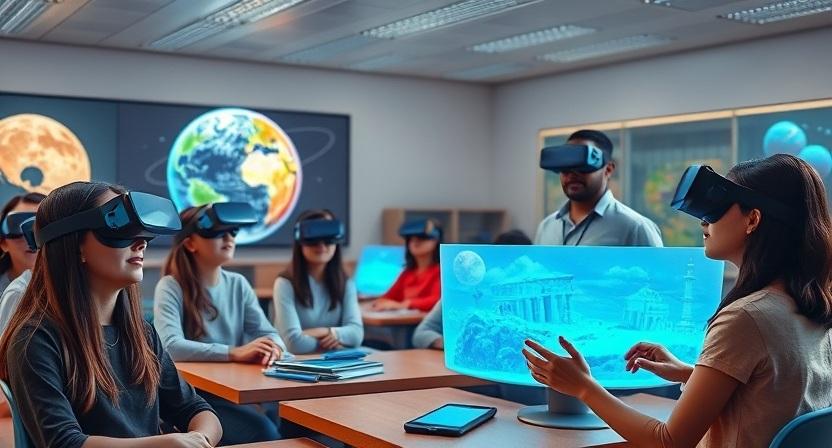How VR Boosts Student Engagement and Retention: Transforming Education
Virtual reality (VR) is no longer a futuristic dream—it’s rapidly reshaping classrooms around the globe. As educators strive to make learning more interactive and memorable, VR offers a game-changing solution. in this article, we’ll explore how VR boosts student engagement and retention, the practical benefits for both learners and teachers, and innovative ways to incorporate VR into educational environments. whether you’re an educator, administrator, or curious learner, discover how VR is transforming education by making lessons immersive, interactive, and unforgettable.
Understanding Virtual Reality in Education
Virtual reality in education involves using immersive technology to simulate real-world environments, scenarios, or abstract concepts.With VR headsets and compatible apps, students can experiance historical events, explore the human body, or travel to distant planets—all without leaving the classroom. This technology goes far beyond traditional lectures and textbooks by placing learners at the heart of the action.
- Immersive learning experiences: Students interact with the content in three dimensions.
- Sensory engagement: VR incorporates visual, auditory, and sometimes tactile feedback, enhancing understanding.
- Accessible exploration: Learners can access environments otherwise impossible or costly to reach in person.
How VR Boosts Student Engagement
Student engagement is the catalyst for deep learning and positive academic outcomes. Here’s how integrating VR into classrooms dramatically enhances engagement:
multi-sensory Stimulation
- Traditional lessons often rely on auditory and visual cues. VR brings in spatial and kinesthetic experiences, sparking curiosity and focus.
- Students can walk through a virtual art gallery, conduct science experiments, or visit ancient civilizations, promoting active participation.
Gamification and Interactivity
- Gamified VR lessons introduce point systems, challenges, and rewards, making learning fun and motivating for all age groups.
- Interactive scenarios allow learners to make decisions, see the consequences, and learn through exploration.
Personalized Learning Paths
- VR platforms can adapt to individual learning paces and preferences,ensuring no one gets left behind.
- students with different learning styles (visual, auditory, kinesthetic) benefit from an engaging, tailored approach.
enhancing Knowledge Retention with VR
It’s not enough for students to be engaged; they need to retain the knowledge, too. Studies show that VR improves knowledge retention rates substantially compared to conventional learning methods. Here’s why:
Active Learning and Memory
- Active involvement, such as solving problems or performing tasks in VR, strengthens neural connections and memory.
- Experiential learning—doing rather than just watching—leads to deeper understanding and long-term recall.
Contextual and Emotional Learning
- VR places learners in life-like contexts, allowing them to practice skills or analyze situations as if they were real.
- Emotional engagement—such as empathy developed during VR history or literature lessons—makes memories stick.
Safe Practice and Immediate Feedback
- VR offers a risk-free environment where students can make mistakes and learn from them without real-world consequences.
- Instant feedback within simulations helps students correct errors on the spot, reinforcing correct knowledge.
Case Studies: VR Transforming Education
Medical Training at Case Western Reserve University
The university uses VR simulations to teach anatomy. Students can explore 3D models of the human body, rotating organs, examining systems, and dissecting virtually. As an inevitable result, retention rates soared compared to traditional textbook methods.
Google Expeditions in K-12 Schools
Hundreds of schools have adopted Google Expeditions, enabling students to virtually visit landmarks, ecosystems, and outer space. Teachers report heightened engagement, improved classroom behavior, and a boost in enthusiasm for learning.
Design and Engineering at Stanford University
Stanford’s School of Engineering integrates VR to let students prototype products and test architectural designs.peer collaboration and self-directed exploration within VR have improved both engagement and project quality.
First-hand Experience: Educators and students share
“When I introduced VR for our World War II unit, my students were visibly more engaged. they explored the Normandy landings and reflected deeply on the human stories. I’ve never seen them so invested in history!”
– Melissa Reynolds,Middle School History teacher
“It felt like I was actually in space. I remembered so much more for my science test because I didn’t just read it—I lived it.”
– Jasmine L.,High School Student
Key Benefits of VR in the Classroom
- Deeper Student Engagement: Immersive content keeps learners focused and curious.
- Increased Knowledge Retention: Experiential learning cements understanding for exams and beyond.
- Improved Accessibility: VR can replicate expensive field trips or perilous experiments safely and affordably.
- Supports Special Needs: Customizable experiences help students with learning differences or disabilities thrive.
- Enhanced Collaboration: Multi-user platforms foster teamwork and interaction skills.
Practical Tips for Implementing VR in Education
- Start Small: Pilot a single VR lesson or module before scaling up schoolwide.
- Choose Quality Content: Select VR educational apps designed by educators and aligned with relevant curricula.
- Invest in Affordable Hardware: Google Cardboard and mobile VR headsets offer budget-friendly entry points.
- Train Teachers: Provide professional progress so educators feel agreeable and confident with VR tools.
- Ensure Digital Safety: Establish clear guidelines for device usage, content selection, and student privacy.
- Measure impact: Regularly assess student engagement and retention, collecting feedback for continuous improvement.
Overcoming Common Challenges
- Budget Constraints: Start with low-cost solutions; seek grants and partnerships for hardware and apps.
- Device Management: Assign devices per group or class and enforce sanitization protocols.
- Screen Time Concerns: Balance VR activities with hands-on and outdoor learning for a holistic approach.
Conclusion: The Future of VR in Transforming Education
Virtual reality is revolutionizing education by making learning dynamic, engaging, and unforgettable. By leveraging the immersive power of VR, educators can boost student engagement and retention, improve academic outcomes, and prepare learners for the challenges of tomorrow. As hardware becomes more accessible and content more innovative, the possibilities for VR in the classroom will only keep growing. Now is the perfect time to embrace this transformative technology and inspire a new era of educational excellence.
Ready to take your classroom to the next level? Explore the latest VR education tools and start making a real impact on student learning today.

